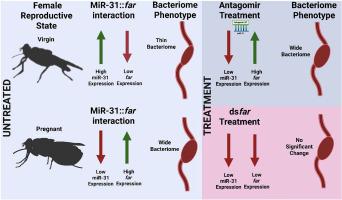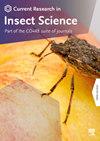Mir-31介导采采蝇细菌组大小的控制
IF 2.7
Q1 ENTOMOLOGY
引用次数: 0
摘要
采采蝇是非洲锥虫病的主要媒介,通过吸血传播。为了补充这种营养有限的饮食,采采蝇与细菌Wigglesworthia舌菌进化出一种义务互惠关系,这种细菌被安置在一个叫做细菌组的特殊器官中。虽然已经研究了这种共生关系对采采蝇适应性的功能贡献,但适应这种关系的宿主形态变化仍然知之甚少。在怀孕的果蝇中,microRNAs (miRNAs)的可变表达调节蛋白表达,但具体影响尚不清楚。妊娠期间,细菌组内脂肪酰基辅酶a还原酶(far)的高表达与miR-31丰度间接相关,且与细菌组大小增加相吻合。我们探讨了far和miR-31在这种形态变化中的作用。虽然RNAi有效地降低了far的表达,但细菌组的大小仍然增加,表明其扩增与far无关。相反,破坏miR-31活性导致处女果蝇的细菌组显着扩大,与交配雌性相似。这些结果表明,miR-31以外的其他基因受miR-31调控,可能有助于妊娠期间细菌组的重塑,可能满足增加的共生需求。最终,破坏这种强制性的互惠关系可能为未来的病媒控制策略提供一个有希望的目标。本文章由计算机程序翻译,如有差异,请以英文原文为准。

mir-31 mediated control of bacteriome size in tsetse flies
Tsetse flies are the primary vectors of African trypanosomes, which are transmitted through blood feeding. To supplement this nutritionally limited diet, tsetse evolved an obligate mutualism with the bacterium Wigglesworthia glossinidia, housed within a specialized organ called the bacteriome. While the functional contributions of this symbiosis towards tsetse fitness have been studied, host morphological changes that accommodate this relationship remain less understood. In pregnant flies, variable expression of microRNAs (miRNAs) regulates protein expression, but the specific impacts are unknown. During pregnancy, high expression of fatty acyl-CoA reductase (far) within the bacteriome is indirectly correlated with miR-31 abundance and coincides with bacteriome size increase. We explored the roles of far and miR-31 towards this morphological change. Although RNAi effectively reduced far expression, bacteriome size still increased, suggesting its expansion is independent of far. In contrast, disrupting miR-31 activity resulted in significantly enlarged bacteriomes in virgin flies, resembling those of mated females. These results suggest that gene(s) other than far are regulated by miR-31 and may contribute to bacteriome remodeling during pregnancy, potentially to meet increased symbiosis demands. Ultimately, disrupting this obligate mutualism may present a promising target for future vector control strategies.
求助全文
通过发布文献求助,成功后即可免费获取论文全文。
去求助
来源期刊

Current Research in Insect Science
Agricultural and Biological Sciences-Animal Science and Zoology
CiteScore
3.20
自引率
0.00%
发文量
22
审稿时长
36 days
 求助内容:
求助内容: 应助结果提醒方式:
应助结果提醒方式:


